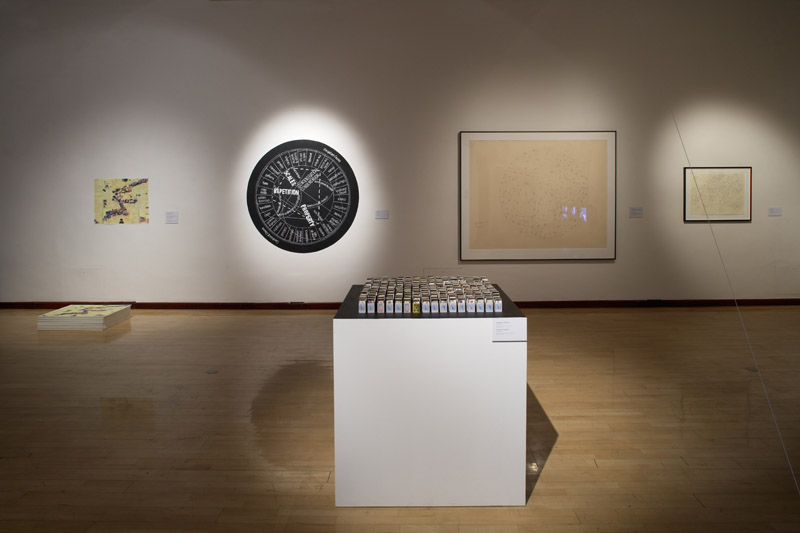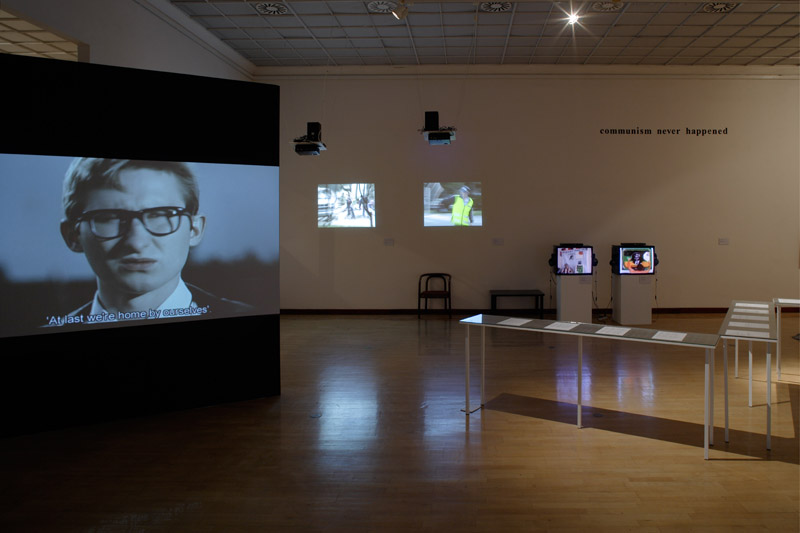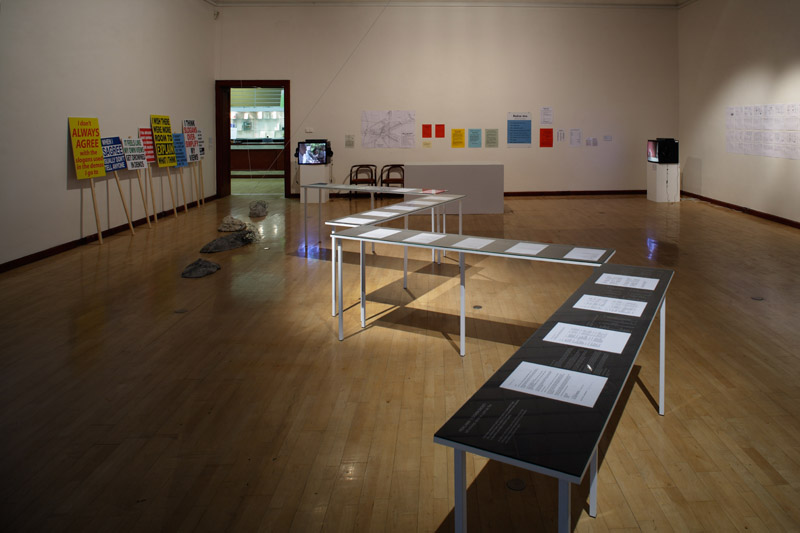“Monument to Transformation” at City Gallery Prague, Municipal Library, Prague (Exhib. Review)
Monument to Transformation, City Gallery Prague, Municipal Library, Prague. May 28 – August 30, 2009
The dictionary defines transformation as a “marked change for the better.” Yet the formerly Communist countries of Eastern and Central Europe – including the Czech Republic – still wonder if the transformations that changed the lives of their citizens so fundamentally over the last two decades – walls were torn down, borders opened – really marked a change for the better. We may have come a long way but where are we now? And where are we headed? Most importantly, how do we perceive the era of transformations and changes now?
 These were some of the questions raised by the show which was curated by Vít Havránek and Zbyn?k Baladrán. Compared with other curatorial efforts in the Czech Republic, both managed to avoid any nostalgia for the so-called “velvet revolution”, or any other revolution for that matter. Instead they shifted the focus to the social developments that have taken us into what the curators refer to as a new “post-transformation” era. This is also the reason why they presented “transformation” as essentially a thing of the past, at least in Eastern and Central Europe. However, they also remind us that transformational social and political changes have been ongoing in many other parts of the world, including Indonesia, South Korea, Spain, Chile, Mexico, Argentina, and the Philippines, and constituted thus a link between cultures and societies considered as other.
These were some of the questions raised by the show which was curated by Vít Havránek and Zbyn?k Baladrán. Compared with other curatorial efforts in the Czech Republic, both managed to avoid any nostalgia for the so-called “velvet revolution”, or any other revolution for that matter. Instead they shifted the focus to the social developments that have taken us into what the curators refer to as a new “post-transformation” era. This is also the reason why they presented “transformation” as essentially a thing of the past, at least in Eastern and Central Europe. However, they also remind us that transformational social and political changes have been ongoing in many other parts of the world, including Indonesia, South Korea, Spain, Chile, Mexico, Argentina, and the Philippines, and constituted thus a link between cultures and societies considered as other.
The effort to escape from a purely local understanding of social transformation was also reflected in the layout of the show. Its first room focused on the personal experiences of individuals who are (or were) directly engaged in overthrowing their political regimes. One of the first videos in this room document Czech artist David ?erný’s use of pink to paint a Russian tank. The tank served as a symbol both of the liberation of Czechoslovakia from the Nazis by the Red Army in 1945 and of the Soviets’ subsequent occupation in 1968. Another video evaluates the May Revolution in the capital of Indonesia (1998) through the eyes of participating students several years after the events. All the participants in the various political and social transformations and revolutions documented in the exhibition – from South Korea to Indonesia and Czechoslovakia – seem to share the same mixture of elation over their achievements and a fear of their possible outcome.
 The remainder of the exhibition was devoted to the lasting consequences of transformational revolutions. Examples included Vahram Aghasyan’s 2005 photographic series entitled Ghost Town depicting the ruins of unfinished social housing in the town of Gyumri, Armenia, through which the artist remind us of the utopian urban development in the Soviet Union, or the notebooks of New York-based Lebanese Walid Raad that traced the psychological effects of the civil war in Lebanon during the years 1975-90. Raad concealed the visual harshness of war by adding colored dots to the places where bullets hit their targets and ironically transforms thus the scene into a subject of aesthetic contemplation. By contrast, Aghasyan presented violent transformation and its results in the rawness of a ghost town.
The remainder of the exhibition was devoted to the lasting consequences of transformational revolutions. Examples included Vahram Aghasyan’s 2005 photographic series entitled Ghost Town depicting the ruins of unfinished social housing in the town of Gyumri, Armenia, through which the artist remind us of the utopian urban development in the Soviet Union, or the notebooks of New York-based Lebanese Walid Raad that traced the psychological effects of the civil war in Lebanon during the years 1975-90. Raad concealed the visual harshness of war by adding colored dots to the places where bullets hit their targets and ironically transforms thus the scene into a subject of aesthetic contemplation. By contrast, Aghasyan presented violent transformation and its results in the rawness of a ghost town.
The absence of any chronology in the presentation of the works in the show had a confusing effect. Works that dealt with very different issues in different contexts were placed next to each other, while others that belonged together were positioned, on the contrary, in total isolation from each other. For example, Walid Raad found itself next to works that targeted neo-liberal practices and their impact on the newly established social structure in Central and Eastern Europe. In an exhibition of such enormous scale such a glaring lack of cohesion results not only in a loss of synergy, it also exposes some works – even some of the more interesting – to the risk of being completely overlooked by the visitor.
 An important theme running through the show was the role played by memory in the assessment of historical process. In Anri Sala’s Interview (1998), the artist interviews his mother about a video that documents her past affiliation with the Albanian Communist party. The intimate setting and the mother’s quiet voice, laced with undertones of shame, highlight the discrepancy between the past and her current experience of it. A similar incongruity dominates Pavel Brail’s video Memory of Events (2002). Compared to Sala’s work with its overtones of documentary, Brail’s is much more abstract and leaves more room for interpretation. The artist keeps turning around his own axis while at the same time he continuously writes words and sentences with a piece of chalk as if in search for history’s definite script.
An important theme running through the show was the role played by memory in the assessment of historical process. In Anri Sala’s Interview (1998), the artist interviews his mother about a video that documents her past affiliation with the Albanian Communist party. The intimate setting and the mother’s quiet voice, laced with undertones of shame, highlight the discrepancy between the past and her current experience of it. A similar incongruity dominates Pavel Brail’s video Memory of Events (2002). Compared to Sala’s work with its overtones of documentary, Brail’s is much more abstract and leaves more room for interpretation. The artist keeps turning around his own axis while at the same time he continuously writes words and sentences with a piece of chalk as if in search for history’s definite script.
If revolutionary transformation was the first part of the show’s overall concern, this theme is being pushed into the background half way through the exhibition. From that point on, the curators focused on the ramifications of the political changes of the last decade in today’s societies. Artur ?mijewski’s video Them (2007) offered a unique view of the differences between conservative Catholics and left wing political groups in Poland. At the same time it reflects on the controversial nature of the neo-liberal political system in which we live today. ?mijewski’s film begins with a discussion of the conservative Catholics with left wing political groups. Each of the groups creates an artifact which embodies their views and believes. Then the artifacts are submitted to the opposing group for a reaction. The session, i.e. the film, ends with an aggressive clash, which results in a total destruction of the created works.
 The inability of various radical groups to communicate with each other and the isolating individualism of modern societies was also the subject of Kate?ina Šedá’s There is Nothing There (2003). In an effort to overcome individual isolation in modern society, Šedá organized (and documented) what was called a “community day” in the village of Pon?tovice in southern Moravia. All the village’s inhabitants were expected to follow a schedule created by the artist so that all of them ended up simultaneously performing a variety of activities, from shopping to sweeping, eating, and socializing. Although rooted in a utopian idea of community, Šedá’s work, which documents the events of the day, had overertones of humor and sarcasm and, like ?mijewski’s, it created a solid platform for further discussion.
The inability of various radical groups to communicate with each other and the isolating individualism of modern societies was also the subject of Kate?ina Šedá’s There is Nothing There (2003). In an effort to overcome individual isolation in modern society, Šedá organized (and documented) what was called a “community day” in the village of Pon?tovice in southern Moravia. All the village’s inhabitants were expected to follow a schedule created by the artist so that all of them ended up simultaneously performing a variety of activities, from shopping to sweeping, eating, and socializing. Although rooted in a utopian idea of community, Šedá’s work, which documents the events of the day, had overertones of humor and sarcasm and, like ?mijewski’s, it created a solid platform for further discussion.
 The uniqueness of Monument of Transformation consisted not only in the variety of the works in the show – some of which had never before been exhibited in the Czech Republic – but also in the way many of them communicated with each other. Although the curators’ somewhat obsessive references to revolution as a starting point to transformation were not always necessary or productive, the exhibition nevertheless reached its goal of providing a space in which the often tumultuous political and social changes of the last twenty years could be seen and discussed both on a global and a local scale. The process of social transformation has been mapped, questions have been raised, and a platform for discussion has been built. Let the debate begin!
The uniqueness of Monument of Transformation consisted not only in the variety of the works in the show – some of which had never before been exhibited in the Czech Republic – but also in the way many of them communicated with each other. Although the curators’ somewhat obsessive references to revolution as a starting point to transformation were not always necessary or productive, the exhibition nevertheless reached its goal of providing a space in which the often tumultuous political and social changes of the last twenty years could be seen and discussed both on a global and a local scale. The process of social transformation has been mapped, questions have been raised, and a platform for discussion has been built. Let the debate begin!





